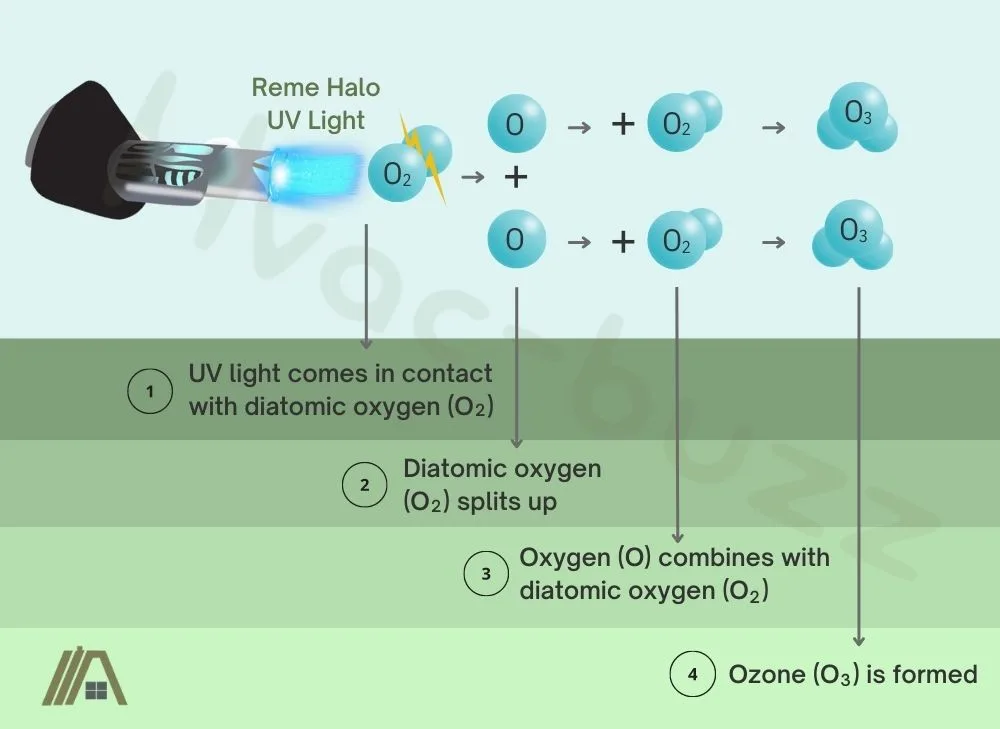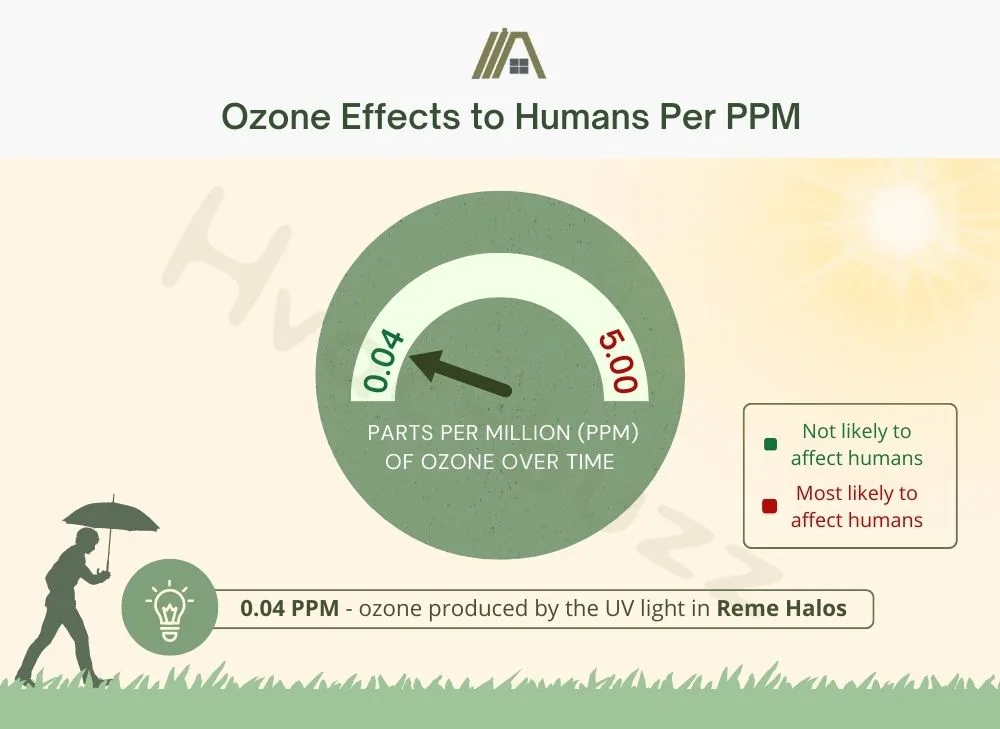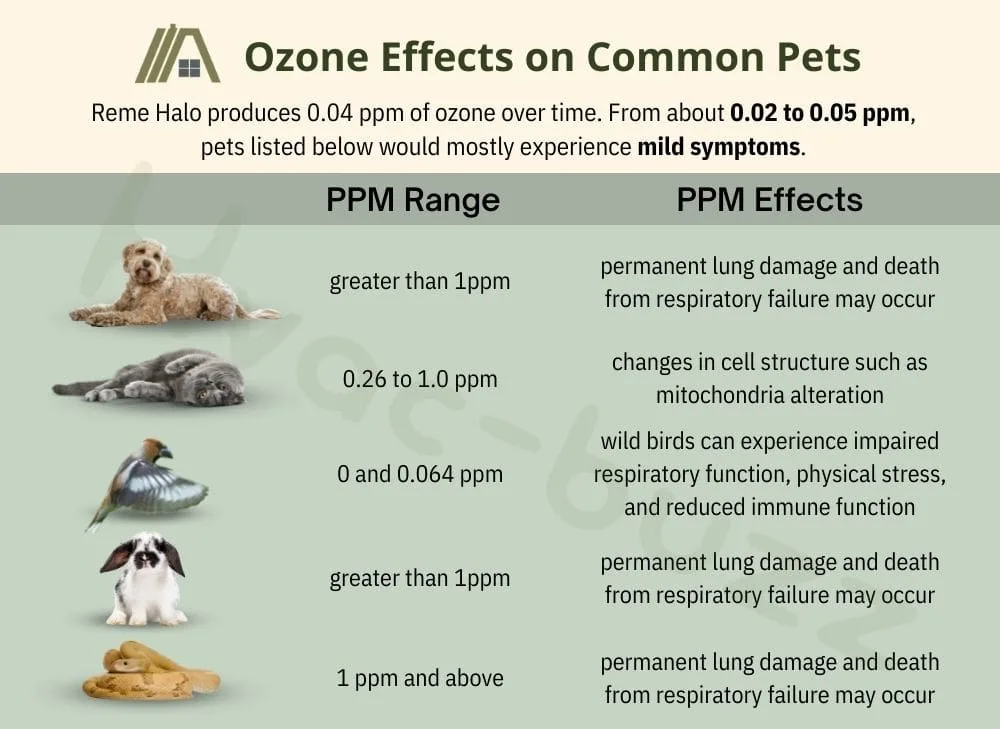A Reme Halo can have seemingly magical effects on the air quality of your home. However, it is not without its downsides, including the production of ozone. It takes a high quantity of ozone to negatively affect humans. But animals and humans are very different and they are often smaller, so it is best to always check what is safe for them instead of just assuming that if it’s safe for us, they will also be fine.
The ions produced by the Reme Halo are harmless, but ozone can be toxic to both humans and animals. Most common pets have similar thresholds of what concentrations are dangerous to them. These thresholds are much lower than a human’s.

Dogs, cats, birds, rabbits, snakes, and lizards are more sensitive to ozone than humans. This is likely due to their smaller size. Reme Halos produce ±0.04 ppm of ozone. Pets are mildly affected by 0.02-0.05 ppm, moderately affected by 0.06-0.08 ppm, and severely affected by 1 ppm and over.
What Is Produced by a Reme Halo?
In order for the Reme Halo to eliminate various air pollutants, it must produce ions, which destroy microbes and cause allergens to clump together to be filtered effectively.
The ions that make this possible are hydroperoxide and zinc ions. Hydroperoxide does most of the work but zinc ions aid as a powerful surface disinfectant.
As mentioned, Reme Halos also produce ozone as a byproduct. Ozone is not one of the ions used for the elimination of air pollutants but can be produced when oxygen comes in contact with the Reme Halo’s UV light.

Are These Products Harmful?
Both hydroperoxide and zinc ions are harmless when they are introduced to your home’s air.
All they will do is disinfect and eliminate various pollutants with no negative impact on any aspect of your home, including your health as well as your pet’s.
Ozone, on the other hand, can be harmful, even toxic in high concentrations.
Symptoms of ozone overexposure are somewhat similar to allergy symptoms. They can include headaches, shortness of breath, and possible aggravation or the development of asthma.
After long periods of ozone overexposure, death from respiratory-related complications can occur.
How Much Ozone Is Produced by Reme Halos?
The ozone produced by the UV light in Reme Halos maxes out at about 0.04 parts per million (ppm) of ozone over time.
Amount Not Likely to Affect Humans
0.04 ppm is a very small quantity. For reference, ozone concentrations are the most dangerous for humans when the concentration is 5 ppm or above. This concentration and higher is likely to lead to permanent damage to your respiratory system and even death.
Although ozone overexposure can lead to frightening health effects, it is very unlikely that your Reme Halo will produce enough ozone to be harmful to you or the human residents of your home.

Ozone from Reme Halo and Common Pets
Pets, on the other hand, may have a different reaction to ozone and may be more sensitive to ozone concentrations that would be harmless to humans.
Dogs
From about 0.02 to 0.05 ppm, dogs will begin to feel the first stages of damage which includes vision damage, cell structural changes, as well as minor respiratory issues.
At ozone concentrations of about 0.06 to 0.08 ppm, the dog is likely to experience more severe respiratory issues such as irritation, higher susceptibility to infections, and reduced lung function. Your dog is also likely to experience extreme fatigue.

If a dog is exposed to ozone concentrations higher than 1 ppm, they are likely to have permanent lung damage within a few hours. Following that, a dog is likely to die from respiratory failure within hours.
Thankfully, the more extreme effects result from concentrations of 0.06 ppm and above. It is very unlikely that a Reme Halo will produce this.
Ranges from 0.02 to 0.05 ppm are possible, though. Although these effects are less severe, they are still painful and damaging to your dog.
Cats
Cats have a similar threshold to dogs when it comes to ozone concentrations.
It can be assumed that concentrations of 0.02 to 0.05 ppm would lead to mild symptoms, and 0.06 to 0.08 ppm would lead to more severe symptoms.
Ranges from 0.26 to 1.0 ppm led to changes in cell structure such as mitochondria alteration. These ranges also led to permanent lung damage as well as lysis (disintegration of a cell) of red blood cells.
As with dogs, Reme Halos can produce ozone levels that can lead to discomfort and damage in your cat.
Birds
Birds are likely to have very similar thresholds to both cats and dogs. They may have even lower thresholds because of their much smaller size.
For example, on an average day with good air quality, the ozone concentrations naturally present in the air are between 0 and 0.064 ppm. Even with these low concentrations, wild birds can experience impaired respiratory function, physical stress, and reduced immune function.
Wild birds are often larger on average than pet birds and, therefore, are more likely to be able to withstand higher ozone concentrations than pet birds. For this reason, pet birds may have an even lower threshold than wild birds.
With this in mind, it is safe to say that Reme Halos are able to produce ozone levels that can harm your pet bird.
Rabbits
Rabbits are thought to have similar thresholds to each pet described above, if not lower because of their small size.
From 0.02 to 0.05 ppm, mild symptoms would be felt. From 0.06 to 0.08 ppm, lung irritation and reduced lung function would likely occur. Levels above 1.0 ppm would lead to permanent lung damage after several hours and possibly death.
As with cats, the specific ranges of symptoms are thought to be similar to dogs, but studies have been done to give specific symptoms at higher levels.
For rabbits, tests of six-hour exposure for three days to 2.0 ppm of ozone were done. The study was done to see the specific effects on the lungs when exposed to high levels of ozone.
It was found that early stages of edema (swelling) occurred as well as decreased blood flow volume and higher pulmonary flow resistance. All of these lead to impaired lung function.
The Reme Halo would be able to produce levels of ozone that can cause discomfort and adverse effects in your rabbit.
Snakes/Lizards
Snakes and lizards have similar thresholds to the above pets.
From 0.02 to 0.05 ppm, minor cell structural changes and respiratory issues will be felt. From 0.06 to 0.08 ppm, more major respiratory issues are likely to occur. Finally, from 1.0 ppm and onwards, permanent lung damage and death from respiratory failure may occur.
One thing that sets reptiles apart from the other pets above is their behavior above 0.6 ppm. Lizards subjected to this concentration of ozone during an experiment experienced behavioral hypothermia.
This is when animals that can regulate their body temperatures, such as snakes and lizards, alter their body temperature to one that is far too low.
The lizard survived this but it is clear that high ozone levels are dangerous for reptiles as well.
As with those above, the Reme Halo has the capability of raising ozone concentration to a level that is uncomfortable and dangerous to your snake/lizard.

Consider the Cumulative Effect
While the most severe effects on pets are seen with ozone levels above those produced by a Reme Halo, these are often not the only ozone-producing appliances in your home. All these appliances added together, may produce enough ozone to increase the risks.
Talk to Your Vet
The ranges given above, as well as their effects, may not be accurate for all pets, especially if your pet has a preexisting condition such as allergies or asthma.
As always, when you have a concern with your pet, your vet is a great resource. Your vet will have an informed medical opinion taking into account conditions your pet may have.

Go With a Halo LED to Be Safe
With every pet listed above, the Reme Halo is able to produce ozone concentrations that can be uncomfortable to your pet or dangerous for their health.
For this reason, it is best to avoid using a Reme Halo because of its production of ozone as a byproduct.
Instead of a Reme Halo, a Reme Halo LED can be used.
As far as how a Halo LED works, it is similar to a Reme Halo but it does not produce ozone. This is because it uses a UV LED light instead of a normal UV light.
Another difference lies in the price. While a Reme Halo is around $400, a Reme Halo LED is about $550. A minor price for peace of mind that your beloved pet is as safe as possible in your home.
If you don’t like the price of the Reme Halo LED, you can look into alternative ionizing air purifiers, like the IWave.
Sources
https://beyerairconditioningheating.com/how-does-the-reme-halo-air-purification-system-work/
https://www.atsjournals.org/doi/abs/10.1164/arrd.1974.110.2.157?journalCode=arrd
https://www.pnas.org/post/podcast/hazards-ozone-polution-birds
https://earthobservatory.nasa.gov/features/OzoneWx/OzoneWx3.php
https://pubmed.ncbi.nlm.nih.gov/2926663/
https://pubmed.ncbi.nlm.nih.gov/15556394/


